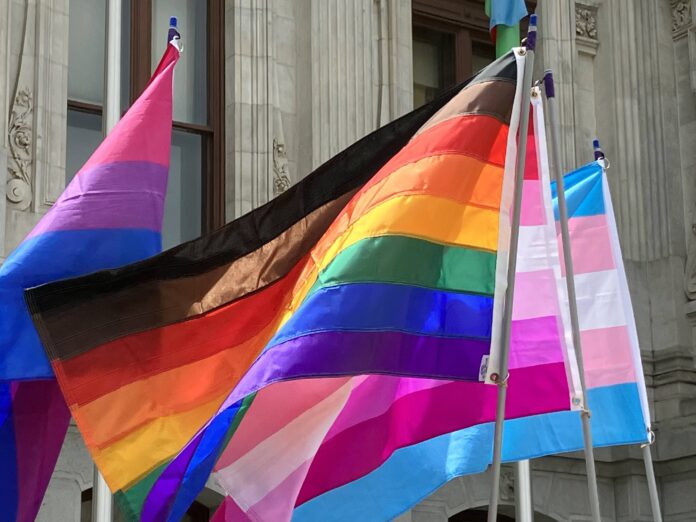A new Gallup poll finds LGBTQ+ identification in the U.S. expanding annually with 7.6% of U.S. adults now identifying as lesbian, gay, bisexual, transgender, queer or some other sexual orientation other than heterosexual. This latest percentage is up a full two percent from 5.6% four years ago and is more than double the 3.5% of 2012, Gallup’s first year of surveying sexual orientation and transgender identity.
Based on aggregated data from 2023 Gallup telephone surveys, the information culled comes from interviews with more than 12,000 Americans aged 18 and older. Gallup asks respondents a set of questions about their identities: whether they identify as heterosexual, lesbian, gay, bisexual, transgender or something else. Overall, 85.6% say they are straight or heterosexual, 7.6% identify with one or more LGBTQ+ groups and 6.8% declined to respond.
Bisexuality Most Prominent
Bisexual adults comprise the largest proportion of the LGBTQ+ population — 4.4% of U.S. adults with 57.3% of LGBTQ+ adults saying they are bisexual. Gay and lesbian are the second most common identities, with each representing slightly over 1% of U.S. adults overall and about one in six LGBTQ+ adults. Slightly less than 1% of U.S. adults and about one in eight LGBTQ+ adults identify as transgender. In the “other” category, the most commonly expressed LGBTQ+ identities given by respondents are pansexual and asexual with each at fewer than 2% of LGBTQ+ adults.
Expanded LGBTQ+ Identification Among Younger Adults
Generation Z and the Millennial generation are far more likely than those in older generations to identify as LGBTQ+. Gallup found that overall, each younger generation is about twice as likely as the generation prior to identify as LGBTQ+. More than one in five Gen Z adults, ranging in age from 18 to 26 in 2023 (born 1997 to 2012), identify as LGBTQ+, as do nearly one in 10 Millennials (aged 27 to 42, born 1981 to 1996). The percentages level off considerably in older generations, with fewer than 5% of Generation X (44-59, born 1965-1989), 2.3% of Baby Boomers (60 to 77, born 1946-1964) and 1.1% of the Silent Generation (78 to 96, born 1928 to 1945).
Bisexuality is the most common LGBTQ+ status among Generation Z, Millennials and Generation X. Fifteen percent of all Generation Z adults — representing more than two-thirds of those with an LGBTQ+ identification — are bisexual.
In the older generations, LGBTQ+ individuals are more likely, or equally as likely, to say they are gay or lesbian than bisexual.
The gender differences reported by Gallup do not include nonbinary people, who represent about 1% of U.S. adults. Gallup states there are not sufficient cases to provide precise estimates of LGBTQ+ identification among nonbinary Americans for 2023 alone, but combined data from 2022 and 2023 indicate that about 80% of nonbinary adults identify as LGBTQ+, with one-third being bisexual and one-third transgender.
LGBTQ+ Identification More Common Among Women
Women are nearly twice as likely as men to identify as LGBTQ+, 8.5% versus 4.7%. Bisexuality is the most common form of LGBTQ+ identification among women, while men are equally likely to identify as bisexual or gay.
Women are more likely than men to have an LGBTQ+ identification in the three youngest generations, especially in Generation Z and the Millennial generation. Close to three in 10 Gen Z women, 28.5%, identify as LGBTQ+, compared with 10.6% of Gen Z men. Among Millennials, 12.4% of women and 5.4% of men have an LGBTQ+ identification.
More than one in five Gen Z women identify as bisexual, as do 9% of Millennial women. Gen Z men are more likely to identify as bisexual than as gay, while nearly equal proportions of Millennial men identify as bisexual or gay. Older generations of LGBTQ+ men are most likely to identify as gay.
The Gallup survey found that 15.3% of Gen Z respondents identify as bisexual, 3% identify as lesbian, 2.6% identify as gay and 2.8% identify as transgender.
“The generational differences and trends point to higher rates of LGBTQ+ identification, nationally, in the future. If current trends continue, it is likely that the proportion of LGBTQ+ identifiers will exceed 10% of U.S. adults at some point within the next three decades,” Gallup said in its report.
Support for Nondiscrimination Protections for LGBTQ+ Individuals Declined
Despite the rise in LGBTQ identification, other data indicates a negative shift in support for LGBTQ people
New data from the Public Religion Research Institute’s (PRRI) American Values Atlas survey found support for same-sex marriage dropped from 69% in 2022 to 67% in 2023. The last time Americans’ support for same-sex marriage dropped in the same survey was between 2014 and 2015, from 54% to 53%.
The survey also showed support for nondiscrimination protections for LGBTQ+ people falling for the first time since 2018. Americans’ support for those protections reached a peak of 80% in 2022, but dropped to 76% last year.
More than three-quarters of Americans supported policies that protect LGBTQ+ Americans from discrimination in housing, employment and public accommodations (76%) in 2023, a decline from a high of 80% the previous year, in 2022.
Americans aged 18-29 show a gradual decrease in support for LGBTQ+ nondiscrimination laws over the last three years, declining from a peak of 83% in 2020 to 75% in 2023.
A majority of members of most religious groups oppose religiously based service refusals, but just 30% of white evangelical Protestants oppose religiously based service refusals, down from 37% in 2022.
Majorities of most religious traditions favor allowing same-sex couples to marry legally. Yet some religious groups show a decline in support from the last year, including Hispanic Catholics, whose support declined from 75% in 2022 to 68% in 2023. Fewer than half of Latter-day Saints, Hispanic Protestants, white evangelical Protestants, Muslims and Jehovah’s Witnesses support same-sex marriage.
Older Americans are less supportive of same-sex marriage than younger Americans. Support among young Americans (18-29) has seen a gradual decline since 2018, when 79% of young Americans supported marriage equality to only 71% in this recent polling.
LGBTQ+ rights drive voting decisions of Democrats more than Republicans, younger Americans more than older Americans.
While support for nondiscrimination protections among Democrats stayed steady from 2022 to 2023, support dropped among Republicans by seven percentage points (from 66% to 59%).
A majority (59%) of independents and more than eight in ten Democrats (82%) oppose allowing small business owners to refuse service to LGBTQ+ people based on their religious beliefs; opposition to such refusals has declined among Republicans, from 40% in 2015 to just 34% in 2023.
A plurality of Americans (38%) say that LGBTQ+ rights is one of various factors they will consider, 30% say they would only vote for a candidate who shares their views on this issue, and 29% say they do not see LGBTQ+ rights as a major issue.
A plurality of young Americans (38%) and members of Gen Z (38%) say they would only vote for a candidate who shares their views on LGBTQ+ rights. Democrats are the most likely to say they would only vote for a candidate who shares their views on this issue (38%), compared with Republicans (29%) and independents (25%).

